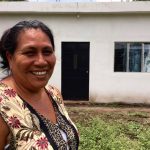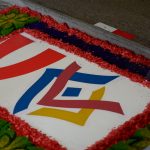The St. Louis College of Pharmacy came to Guatemala on a special trip that counted for college credits. Want to know what a trip is like? Check it out below!
January 5

After 2 plane rides, a night in Guatemala City, and a 4 hour bus ride, we finally made it to our hotel in Retalhuleu, Guatemala! During our bus ride, we were able to see several volcanos towering over the forests through the window.
Perhaps the best part of our day was meeting with the families whose homes we will be building. The first family was represented by Olga, the mother of an 11 year old daughter and two adorable 18 month old twin boys. Currently, this family of 5 lives in Olga’s mother’s house under very crammed conditions…
Read the full post here.
January 6
We report to you today with sore muscles and a bit of a suntan. If you couldn’t guess it, today was our first day on site! We started off our day by eating breakfast at the hotel. Our meal consisted of two eggs, each topped with different colored salsas, which we later learned was a dish that the Guatemalans call the “divorced eggs.”
At the work site where Olga’s house is being built, the foundation had been previously laid and the team primarily worked on preparing rebar and cinder blocks for the next step in the construction process. Besides this, the team also filled in many trenches along the work grounds with dirt and leveled the work site in order to continue at the site tomorrow. At the other work site building Selvian’s house, the team is currently working on laying the foundation, so they spent most of their time tying rebar as well as moving multiple loads of gravel and cinder blocks in preparation for the foundation that is soon to come…
Read the full post here
January 7

After breakfast, we mixed up the work teams from yesterday and headed to our sites. There, we attempted new skills or built upon skills learned yesterday and had the opportunity to interact with a new family. After mixing a lot cement, moving a lot of bricks, and tying a lot of rebar we went back to the hotel for lunch. The hotel has offered a great mix of cultural foods and American foods for us.
Tonight, we had two special moments. The first came when one of our team leaders, Ronnie shared a story of why he decided to dedicate his life to volunteering. He told us a story of visiting Guatemala and how 5 US dollars helped saved a family friend. That was the moment he decided to make real change in the life of others. Our second special moment came when we were able to see local kids and adults play in band performance right outside the hotel (pictured above). Although we were all tired from our day of work, we couldn’t help but smile at these talented and passionate kids. Those are the moments we’ll remember when asked about this trip; those are the memories we came to make…
Read the full post here
January 8

Another day of work accomplished! We started our day with breakfast at the hotel (and coffee, of course). Our morning devotion, shared by Jocelyn, encouraged us all to “Either find a way or make one.” This trip is all about learning to solve new problems and dis covering new ways of thinking.
The work is definitely not easy, but very rewarding. Getting the chance to interact with the families makes all of our hard work worth it. We then headed back to the hotel for lunch. Here, we enjoyed sandwiches, fries, and a traditional Guatemalan hibiscus juice. Back at the worksite, one team got the chance to observe a traditional Guatemalan funeral procession. The whole neighborhood gathered for this…
Read the full post here
January 9

Work hard, play hard is a perfect motto to sum up our team’s day. We began our Saturday with breakfast and a very meaningful biblical devotion from Luke 10:25-37. It stressed the importance of loving your neighbor as yourself even when it is not convenient for you. This was a perfect reminder of our purpose along with Habitat for Humanity’s purpose here in Guatemala.
With this message in mind, along with our work gloves and water bottles in hand, we loaded up in the vans for another day’s work. This day was a little different from the others…it was cut short for a trip to the beach! Although it was hot, pouring cement and tying rebar seemed to go much quicker with views of the ocean in the near.
To top the day off we ended with a trip to a local turtle conservation area. Although the main hatching season is from July to December and no turtles were present, it was still an interesting sight to see. We were all fascinated by the amount of impact this organization had on the turtle population…they alone helped save over 4,000 turtles this season!
With our sunburnt skin and bellies full, we all left the beach and headed back to the hotel. As usual, we ended the night with a delicious dinner and card games to follow. We all plan to get a good night’s rest as another busy day awaits…
Read the full post here
January 10

Sunday Funday! The day started with some members of our team heading to mass. At breakfast, we were happily joined by Ronnie’s family. Per usual, we started our day with a devotion lead by Matthew, which encouraged us to practice empathy.
Our first stop of the day was the Tak Alik Abaj Mayan ruins, where Ronnie translated the entire tour from Spanish to English for the group. Although only 8% of the ruins are completely excavated, we were able to tour parts of the city where most business and prayers was conducted. A few facts we learned today were:
1. The Mayans held the sun in high esteem during prayer. Even homes of important people faced the direction of the rising Sun in the East.
2. The jaguar was an animal that symbolised power to the Mayans, and jade was a symbol of both power and prestige.
3. There were no metal tools during this time, so the stone carvings and hieroglyphics were made with other stones.
4. The world’s oldest Mayan burial site is dated back to a location we were able to see and it was believed to date back to 700 B.C….
Read the full post here
January 11

Back to work today! Instead of splitting into two teams as usual, all members of the team went to one site. This was to move cinder blocks from one side of the site to the other so the masons coils build up the walls. Although moving blocks sounds easy, it proved to be the ultimate team building adventure. We formed a long line and passed the blocks down one by one. This process would go on for quite a few hours (with breaks, of course). After we moved blocks at one site, we moved all the blocks at the other site as well. With aching muscles and dirty clothes, we packed into the vans and headed back to the hotel.
Dinner was a lovely display of stuffed chicken and mashed potatoes. Afterwards, the group had a discussion on empathy, altruism, and justice. However, the main lesson of the day and of most of this trip proved to be teamwork. Without the help of our peers, we could never have accomplished the almost impossible task of moving literally tons of cinder blocks and to help build these houses…
Read the full post here
January 12

To get back to our hotel, we decided to use these very small cars called “tu tics.” They were red and could only hold about three people. To me, they looked and sounded like go-karts. These vehicles are a very common mode of transportation around this city. Riding them was a fun experience. After our trip from the market, we all stood with one of the drivers and took a picture (picture above).
During our discussion after dinner, we talked about how we use every ounce of life out of the tools we are given on the job sites. From tying chicken wire around bolt cutters instead of buying new ones to using the back side of a machete instead of a sharp hatchet, the tools we use are important and we find ways to keep using them as best as we can. In America, labor is more expensive than the tools, but down here, the tools are a much greater expense. Lastly, we talked about the importance of empathizing with patients and how we should not take their frustration for face value. Every person fights their own battles. Therefore, as professionals we should respect them and attempt to understand our patients’ actions from their points of view.
Read the full post here
January 13

If there is one thing that has become overwhelmingly obvious over the course of this trip, it’s that each and every one of us loves nothing more than getting some sleep. We appreciate our rest so much that most of us practically inhale our lunches in a matter of minutes just to make some time for a quick siesta before heading back to the worksite! Because it’s true that we cherish every moment in bed, we were all overjoyed that we got the chance to sleep in an extra hour this morning. At breakfast, Alexa led the devotional and shared the following Maya Angelou quote: “I’ve learned that people will forget what you said, people will forget what you did, but people will never forget how you made them feel.” I think this quote really hit home for many of us; the conversations we have with the families we are working with will not be something they remember for the rest of their lives (because most of a speak more Spanglish than we do Spanish). However, what I truly hope will last a lifetime is the mutual feeling of love and respect that can be felt between us, the families, and the masons.
Read the full post here
January 14

All good things must come to an end. As we all woke to the usual hustle and bustle of Retalhuleu and headed to breakfast, there was a sense of sorrow that filled the air. We all knew today was the last day on the sites with the crews and families to whom we had grown so close. We divided up into teams per usual and headed off for our final day of work.
The ceremony consisted of the masons thanking us for our hard work over these past two weeks and then members of our team giving them signs and bibles for their new homes. Mary Lou and Mathew then took the stage and presented photos of the team as well as paper hearts all signed by the team members to Selvian and Olga. The hearts will be place in the wall of the house to let the families know we will always be with them and the are never alone while the photos will give them something to look at and remember these great two weeks we shared. Then, the local affiliates surprised us all by calling us up individually and giving each of us personalized wooden plaques that where hand made and engraved with our names and Mayan artwork.
Read the full post here
















 a small farming community, to help improve families’ health by eliminating the smoke that lingers inside the kitchens. One volunteer group saw the reason for the improved stove right off the bat:
a small farming community, to help improve families’ health by eliminating the smoke that lingers inside the kitchens. One volunteer group saw the reason for the improved stove right off the bat: it’s hot. Usually it’s only a finger but it still hurts when you burn yourself.»
it’s hot. Usually it’s only a finger but it still hurts when you burn yourself.»









 years, improving design details so that houses are more sustainable, easier to clean and maintain, and affordable. Our model has always utilized cement block walls, but on this week of celebration, we are shaking things up. Our architects have introduced a model of housing that uses metal framing with pre-manufactured cement paneling instead of cement blocks. The model is equally priced, but it’s said to be sturdier. We symbolically used housing solution 75,001 as a test for the house in Tecpán.
years, improving design details so that houses are more sustainable, easier to clean and maintain, and affordable. Our model has always utilized cement block walls, but on this week of celebration, we are shaking things up. Our architects have introduced a model of housing that uses metal framing with pre-manufactured cement paneling instead of cement blocks. The model is equally priced, but it’s said to be sturdier. We symbolically used housing solution 75,001 as a test for the house in Tecpán.

 Walt is a constructor. In fact, he’s owned his own construction business for 18 years back in the United States. But during his volunteer time in Guatemala, he prefers to keep that a secret, limiting his leadership as he takes direction from the lead mason, a Habitat Guatemala employee. He tells the story as he smooths cement with evident experience.
Walt is a constructor. In fact, he’s owned his own construction business for 18 years back in the United States. But during his volunteer time in Guatemala, he prefers to keep that a secret, limiting his leadership as he takes direction from the lead mason, a Habitat Guatemala employee. He tells the story as he smooths cement with evident experience.










 In October, we did a special volunteer home build. It was an exploration of women’s issues in Guatemala and how they relate to building homes. The 10-day experience was a huge success, partially because volunteers were able to experience daily Guatemalan life and go deeper into what that really means.
In October, we did a special volunteer home build. It was an exploration of women’s issues in Guatemala and how they relate to building homes. The 10-day experience was a huge success, partially because volunteers were able to experience daily Guatemalan life and go deeper into what that really means.
 People continue flooding into Guatemala City, above, from other parts of the country in hopes that they may escape poverty – or find any job at all. Often, they end up compromising their safety for cheaper housing by living on the side of a slope.
People continue flooding into Guatemala City, above, from other parts of the country in hopes that they may escape poverty – or find any job at all. Often, they end up compromising their safety for cheaper housing by living on the side of a slope.

 4) I was able to do what I love
4) I was able to do what I love


 9:15 A.M. – Duty calls, ran over to work site to help our family with the concrete for the foundation of their house. Duties included wheel barrowing material from one place to place, passing buckets of concrete as part of a 10 person bucket brigade, shoveling, cracking jokes etc….
9:15 A.M. – Duty calls, ran over to work site to help our family with the concrete for the foundation of their house. Duties included wheel barrowing material from one place to place, passing buckets of concrete as part of a 10 person bucket brigade, shoveling, cracking jokes etc….
 4:00 P.M. – Made it to the beach! Time to jump in and cool off from this heat.
4:00 P.M. – Made it to the beach! Time to jump in and cool off from this heat.
